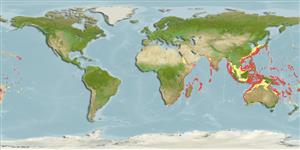Elasmobranchii (Haie und Rochen) (sharks and rays) >
Myliobatiformes (Stingrays) >
Plesiobatidae (Deepwater stingrays)
Etymology: Plesiobatis: Greek, plesios = near + Greek, Greek, batis, batidos = a ray (Raja sp.) (Ref. 45335).
Environment: milieu / climate zone / depth range / distribution range
Ökologie
seewasser bathydemersal; tiefenbereich 44 - 780 m (Ref. 58302), usually 275 - 680 m (Ref. 9914). Deep-water; 39°N - 37°S, 20°E - 154°W
Indo-Pacific: South Africa, Mozambique, southern India, east to the Philippines (Ref. 5281), north to Japan and south to Australia. Also reported from the Hawaiian Islands.
Length at first maturity / Size / Gewicht / Alter
Maturity: Lm 194.5, range 189 - 200 cm
Max length : 270 cm TL Männchen/unbestimmt; (Ref. 3263)
Rückenflossenstacheln (insgesamt): 0; Rückenflossenweichstrahlen (insgesamt): 0. A giant plain stingray with a broadly pointed snout, small eyes and a round disc; tail short with a long caudal fin and a narrow sting; upper surface covered with denticles (Ref. 5578). Grey-black to brownish or purplish-brown above, white below; rear edges of pelvic fins and tail grey; disc edges black, and sting light (Ref. 5578).
Found on the outer shelf and upper slope (Ref. 5578), on soft bottoms (Ref. 9914) at depths of 275-680 m (Ref.58048). Benthic (Ref. 58302). Feeds on small pelagic fish, eels, crabs, shrimp, lobsters, cephalopods and polychaete worms (Ref. 5578). The specimen taken from a depth of 44 m was caught off Mozambique (Ref. 9914). Its sting is long and can inflict a painful wound if handled. Caught occasionally by demersal longline fisheries in deepwater. Utilized for its meat, but not of a particularly high value (Ref.58048).
Life cycle and mating behavior
Geschlechtsreife | Fortpflanzung | Ablaichen | Eier | Fecundity | Larven
Nishida, K., 1990. Phylogeny of the suborder Myliobatidoidei. Mem. Fac. Fish. Hokkaido Univ. 37(1,2) (serial no. 54):1-108. (Ref. 7444)
IUCN Rote Liste Status (Ref. 130435)
Bedrohung für Menschen
Venomous
Nutzung durch Menschen
Fischereien: weniger kommerziell
Mehr Information
ReferenzenAquakulturAquakultur ProfilZuchtlinienGenetikElectrophoresesVererbbarkeitKrankheitenVerarbeitungNutrientsMass conversion
PartnerBilderStamps, Coins Misc.LauteCiguateraGeschwindigkeitSchwimmstilKiemenoberflächeOtolithsGehirngrößeSehfähigkeit
Tools
Zusatzinformationen
Download XML
Internet Quellen
Estimates based on models
Preferred temperature (Ref.
123201): 6.7 - 14.3, mean 9.7 °C (based on 641 cells).
Phylogenetic diversity index (Ref.
82804): PD
50 = 1.5000 [Uniqueness, from 0.5 = low to 2.0 = high].
Bayesian length-weight: a=0.01000 (0.00244 - 0.04107), b=3.04 (2.81 - 3.27), in cm total length, based on all LWR estimates for this body shape (Ref.
93245).
Trophic level (Ref.
69278): 4.0 ±0.66 se; based on food items.
Widerstandsfähigkeit (Ref.
120179): niedrig, Verdopplung der Population dauert 4,5 - 14 Jahre. (Assuming fecundity<100).
Fishing Vulnerability (Ref.
59153): Very high vulnerability (90 of 100).
